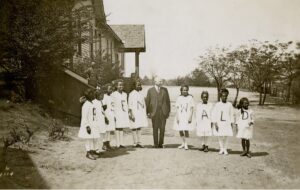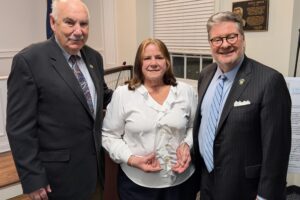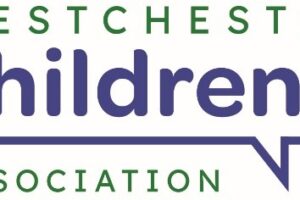
In a time of growing antisemitism and racial tensions both locally and nationally, it is heartening to discover an exhibit that highlights the collaboration between the Black and Jewish communities to create an opportunity for greater good. The exhibit focuses on the Rosenwald Schools, referencing the thousands of schools that were created to support the education of Black people in the South during the Jim Crow era.
The exhibit is part of a larger Black History Month show, Black History and Culture: Black Presence. Profound Influence, which runs from Feb. 2 to March 8 at the Bethany Arts Community in Ossining. (This larger show was covered in an article in River Journal in January.)
According to Ossining Village Historian Joyce Sharrock Cole, the show’s curator, “It’s an exhibit featuring the historic partnership between the Black and Jewish communities.” The show highlights the relationship between Julius Rosenwald, a Jewish philanthropist and owner of the Sears, Roebuck and Co., and Booker T. Washington, who was born into slavery and created the Tuskegee Institute, a historically black college. The two were the force behind the creation and construction of the Rosenwald Schools.
According to Cole, “The two men used their resources, their intellectual property and their compassion for people in order to better the world.” Their groundbreaking partnership in the early decades of the 20th century led to a transformative creation of some 5,000 schools for Black children in 15 Southern and border states between 1912 and 1932.

The Rosenwald exhibit, which is one room inside the larger exhibition, is a physical recreation of an actual school that existed in Notasulga, Ala., called the Shiloh-Rosenwald School. “It was a one-room school, and all one-room schools had the same plan, which is based on the Sears’ box houses from the time,” says Cole.
Based on conversations Cole had with the Shiloh school, Cole was able to recreate the inside of the school room in its entirety, from desks and chairs to the books that students might have studied from. There will also be photos of other Rosenwald Schools as well as architectural designs for the one, two- and three-room schools that were built.
“What’s great about the Rosenwald Schools is that there had to be a collaboration. Rosenwald did not just give the money away,” says Cole. “The Black community had to participate in the building of schools, coming up with the land or raising the money, often through bake sales and fish fry dinners as well as other events. They also helped in buying the materials and building the schools. The white school districts needed to donate money as well. Then Julius would fund the rest. It is one of the earliest examples of a matching grant.”
Cole says another instance of collaboration between the Black and Jewish communities, is that it was two Ossining Jewish residents, Joanna Cohlan and Marcia Grubel, who approached Cole with the idea for the Rosenwald exhibit and have been intricately involved in its development and installation. The two were inspired by the documentary film Rosenwald.
According to Cohlan, the Rosenwald Schools “blend the cultural mandate of Martin Luther King, Jr. and the “I have a dream” speech with the Jewish tradition of ‘tikkun olam, healing the world.”
Grubel adds, “I think that in light of what is happening today, we need an inspiring story, and we need a role model for moral leadership. The relationship between Julius Rosenwald and Booker T. Washington speaks to that.”
Abbe Marcus, executive director of the nonprofit Journeys to Change, says, “The opportunity to build and strengthen relationships between the Black and Jewish communities through partnerships is so important. This story about Julius Rosenwald and Booker T. Washington helps us recognize the value of friendships, and the responsibility and power each person has to help each other and make the world a better place.”
Tours of the exhibit will be led by docents from the Ossining and Tarrytown school districts, involving students from the fifth to 12th grades (who have been trained by Cole). In addition, BAC has partnered with the two school districts to bring 4,000 student visitors and families in 2024. There are also adult docents, and more are welcome to enlist. For information on becoming a docent, email julias@bethanyarts.org.
Black History Month programs at Bethany Arts Community are sponsored by Theater O, Journeys to Change, the Maurice D. Hinchey Hudson River Valley National Heritage Area, and Revolutionary Westchester 250.
PHOTO: ROSENWALD2
CAPTION: Julius Rosenwald and Booker T. Washington at Tuskegee Institute in 1915. Photo courtesy of Special Research Center, University of Chicago Library
PHOTO: ROSENWALD1
CAPTION: Julius Rosenwald with students from a Rosenwald school. Photo courtesy of Fisk University John Hope and Aurelia E. Franklin Library






